|
Are Christmas Cards a Dying
Breed?
by Bob Brooke
Times change. It used to
be that people sent loads of Christmas cards. Some sent 100 or more. But
with the rising cost of postage and less time people have to sit down
and write out greeting cards, it’s no wonder that fewer people are
sending them today.
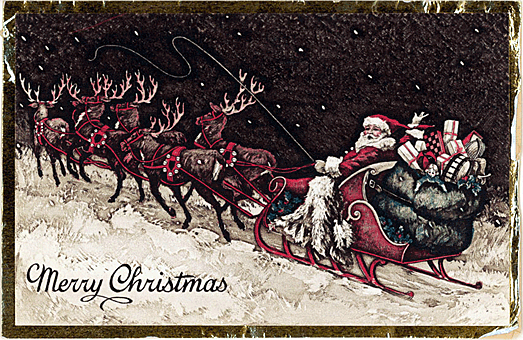
Technology has also played a role in the demise of the Christmas card.
Today, people have other, faster ways to send greetings by Email or
through social media sites like Facebook. So with fewer cards being
sent, older cards have increased in collectibility. Though people take
Christmas cards for granted these days, there was a time when they were
a novelty.
The First Christmas Card
The earliest known holiday greeting cards, primarily made from woodcuts,
appeared around 1450 in Germany. Most featured the Christ Child bearing
good wishes for the New Year. During the 15th century, people exchanged
handmade greeting cards throughout Continental Europe. By 1770, finely
printed and engraved cards replaced the woodcuts which bore New Year's
greetings. Advances in lithography, printing and mechanization, as well
as the 1840 introduction of the postage stamp, continued the evolution.
By the 1850s, the greeting card had been transformed from an expensive,
handmade and hand-delivered gift to a popular and affordable means of
personal communication.
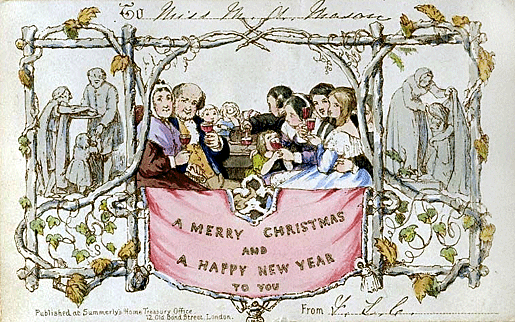
Sir Henry Cole, a public
servant, art patron, educator, and the first director of London’s
Victoria and Albert Museum, would sit down and write greetings to his
family and friends. But as his circle of friends grew, writing each a
note took too much time. In 1843, he hired artist John Calcott Horsley
to design a holiday card that he could send to his friends. This first
hand-colored lithographed Christmas card featured three panels. The
center panel featured a three-generation family gathered around a table
eating and drinking. The left panel was about feeding the hungry during
the holiday season, and the right panel depicted the need to gather
clothes for the needy. The greeting in the center was “Merry Christmas
and A Happy New Year To You.” Of course, this type of greeting would
become standard on almost every Christmas card in the future. Cole had
1,000 cards printed and those he didn’t use, he sold in a local shop.
Only a dozen still exist.
Horsley's card met with the disapproval of temperance groups because it
pictured a family with wine glasses raised in a toast. The controversy
did nothing to dissuade the tradition. In fact, many believe it actually
aided in popularizing the custom.
A Christmas card by W. C. T. Dobson entitled “The Spirit of Christmas”
appeared in 1844. This second card sold more than the previous year's
card. The tradition of sending Christmas greetings had caught on.
However, the tradition of sending Christmas cards didn’t catch on right
away in the United States. In 1850 R. HR Pease's Great Variety Store,
located in Albany, New York, printed up a card featuring a lithographed
Santa Claus with a family enjoying presents while a servant set the
table for Christmas dinner. It was part card and advertisement for the
store.
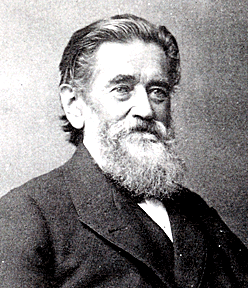 But
it was a German immigrant, Louis Prang, who historians credit with
starting the greeting card industry in the U.S. In 1856, he opened a
small lithographic business near Boston. He continued to perfect the
color lithographic process. In the early 1870s, Prang published deluxe
editions of Christmas cards, which found a ready market in England. In
1875, he introduced the American public to its first complete line of
Christmas cards. He invented a technique he called "chromolithography,"
which was a process that employed up to 45 color plates for one picture.
Eventually, Prang closed his deluxe greeting business in the early 1890s
as a result of an influx of cheap imitations from his native Germany. But
it was a German immigrant, Louis Prang, who historians credit with
starting the greeting card industry in the U.S. In 1856, he opened a
small lithographic business near Boston. He continued to perfect the
color lithographic process. In the early 1870s, Prang published deluxe
editions of Christmas cards, which found a ready market in England. In
1875, he introduced the American public to its first complete line of
Christmas cards. He invented a technique he called "chromolithography,"
which was a process that employed up to 45 color plates for one picture.
Eventually, Prang closed his deluxe greeting business in the early 1890s
as a result of an influx of cheap imitations from his native Germany.
An Industry is Born
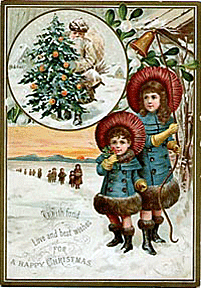 Prang's
timing was right. By 1898, the production of postcards eclipsed that of
greeting cards. He enjoyed tremendous popularity until 1918. During this
Golden Age, millions of postcards were published and at the turn of the
20th century, the New York City post office handled as many as 30,000
postcards every day. In 1909, North Americans purchased more than one
billion postcards, roughly twice the amount sold, today. Most sold for
about a penny apiece, with millions printed for occasions such as
Christmas. Prang's
timing was right. By 1898, the production of postcards eclipsed that of
greeting cards. He enjoyed tremendous popularity until 1918. During this
Golden Age, millions of postcards were published and at the turn of the
20th century, the New York City post office handled as many as 30,000
postcards every day. In 1909, North Americans purchased more than one
billion postcards, roughly twice the amount sold, today. Most sold for
about a penny apiece, with millions printed for occasions such as
Christmas.
Cards cane in many shapes and sizes, shaped oval or like bells, shoes or
other objects. Silk fringe and perfumed sachets on the cards were also
popular.
At the turn of the 20th century, sending Christmas greetings began a
resurgence in the form of postcards. Gone were the elaborate Victorian
cards replaced by the “penny postcard.” The period from 1900 to 1920
became the "Golden Age of Postcard Christmas Cards." It’s from this time
that collectors seek the most valuable collectible cards.
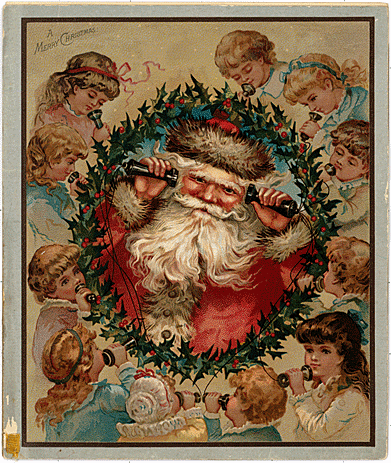 Appearing
on cards was an entire set of new figures and objects. Children playing
in the snow, Santa Claus, St. Nicholas, village scenes, birds sitting on
tree branches with snow covered homes in the background, angels,
nativity scenes, and even boys in hunting scenes with their dogs—all
became popular Christmas card subjects. Appearing
on cards was an entire set of new figures and objects. Children playing
in the snow, Santa Claus, St. Nicholas, village scenes, birds sitting on
tree branches with snow covered homes in the background, angels,
nativity scenes, and even boys in hunting scenes with their dogs—all
became popular Christmas card subjects.
The image of Santa Claus appeared in many variations. He appeared as a
woodsman dressed in fur with a purple, green, blue and white coat. In
European versions, Santa Claus appeared wearing a hood on his fur
trimmed ;red coat. Some versions of Santa Claus are rare and valuable.
Cards featuring him in an automobile or airplane are more valuable than
the traditional sleigh and reindeer samples. Automobile examples can
range in value from $20 to several hundred. One version of Santa Claus
driving a car was made to be held to the light. This card sells in the
$200 range.
Postcards were also the inspiration behind two major greeting card
publishers. Jacob Sapirstein, who borrowed $50 from a local bank in
Cleveland to buy a supply of penny postcards, founded the first,
American Greetings Corporation, in 1900. The first week, Sapirstein sold
enough cards to drug stores and confectioners to repay the loan and have
$50 for the next week's business. The most popular designs in his early
product line expressed feelings using rhythmic prose and flowery
Victorian artwork.
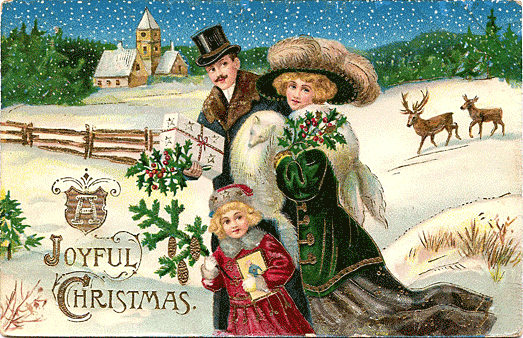
The Beginnings of Major Greeting Card
Companies
New American card companies began to appear prior to World War I. In
1910, 18-year-old Joyce Clyde Hall stepped off a train in Kansas City,
Missouri, with nothing but two shoeboxes of postcards under his arm.
Hall printed some invoices and started sending packets of 100 postcards
to dealers throughout the Midwest from his room at the YMCA. His gamble
paid off. While a few of the dealers kept the cards without paying and
some returned the unsolicited merchandise with an angry note, about a
third sent a check. Within a couple of months, Hall had cleared $200 and
opened a checking account.
That same year in Kansas City, Fred Winslow Rust began selling cards
from his small bookstore. He founded Rust Craft Cards and introduced the
first enveloped-style card.
But Hall had aspirations beyond postcards, and in 1915, he and his
brother Rollie began creating and printing their own cards under the
name Hall Brothers. Their instincts proved right. The postcard craze
ended with World War I, while greeting cards continued to gain
popularity and become more decorative. Initially, the Hall Brother's
limited production to Christmas and Valentine's Day and thus began
Hallmark Cards.
The Influence of World War I
At the start of World War I, the U.S. Government banned Christmas cards
for security reasons and to conserve paper for the war effort. Later,
the Government realized that cards could be a boost to morale on the war
and home front. Many cards had a patriotic theme with red, white and.
blue ribbons or chords attached. Verses were uplifting—“Best Christmas
Wishes, Uncle Sam has called, and I can't be home to say, How much I
wish you well, Each hour of Christmas Day.”
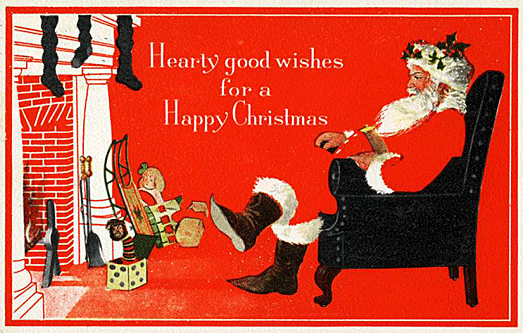
Sadly with the end of the war came the end to not only to the postcards,
but also to their quality. Their popularity meant more had to be
produced and with mass-production concern about the beauty of the cards
became secondary to merely turning them out.
Designs weren’t very elaborate and reflected the1920s-Art Deco style.
They featured themes and illustrations focused on sleighs, horse and
carriages and New England-style churches in muted colors. Animal themes
of red-breasted birds, deer, and domestic pets also continued to be
popular. Postcards from this era can be found easily and are an
inexpensive item to start and build a collection. In many instances,
they can be found for less than a dollar.
 Following
World War I, new publishers entered the field and healthy competition
produced important innovations in printing processes, art techniques and
decorative treatments for greeting cards. During the 1920s, Christmas
cards were often hand-painted and stylized cards showed the influence of
Art Deco. Following
World War I, new publishers entered the field and healthy competition
produced important innovations in printing processes, art techniques and
decorative treatments for greeting cards. During the 1920s, Christmas
cards were often hand-painted and stylized cards showed the influence of
Art Deco.
The folded Christmas card replaced the postcard during the Great
Depression. Many poked fun at poverty and prohibition. According to
Hallmark, one of their cards from 1932 actually wishes the recipient
your favorite brand of holiday cheer. Movies were also becoming a major
form of entertainment, and animated, stars, like Popeye and Mickey
Mouse, began to appear on Christmas cards.
The Christmas Card and World War II
By 1941, there were about 100 card publishers, generating approximately
$43 million in wholesale .card sales. But 1941 also brought risk to the
greeting card industry, as the United States War Department carried out
an initiative to conserve paper by 25 percent. To ward off potential
disaster, the Greeting Card Association was formed. The association
successfully launched a Defense Stamp Christmas Cards program, and
V-mail greeting card promotion, both aimed to endorse defense stamps and
war bonds. As could be expected, during the war years, Christmas cards
with patriotic messages and flags were much in demand.
 Many
portrayed Santa Claus and Uncle Sam carrying flags. Card makers created
messages especially for servicemen overseas that are common today, such
as "Missing You" and "Across the Miles." Cards from the 1940s also
reflect advances in printing technology, such as the use of four-color
printing. One of the most valuable cards of the War features Santa
wearing an aviator cap and goggles while dropping presents out of the
bomb bay door of an aircraft. Many
portrayed Santa Claus and Uncle Sam carrying flags. Card makers created
messages especially for servicemen overseas that are common today, such
as "Missing You" and "Across the Miles." Cards from the 1940s also
reflect advances in printing technology, such as the use of four-color
printing. One of the most valuable cards of the War features Santa
wearing an aviator cap and goggles while dropping presents out of the
bomb bay door of an aircraft.
Card companies also employed Christmas themes on cards to keep the
morale high on the home and War fronts. Christmas bells, holly and ivy,
candy canes, sleighs traveling on snow covered bridges and Yule logs
reminded everyone there was something to fight for and once the War was
over there could be a return to a world at peace. Hallmark began to put
glitter on its cards to give the image of snow on the trees or ground.
When the war ended and the baby boom began, photographic cards became
very popular. The picture of the entire family under the tree or a
picture of the children visiting Santa Claus were popular themes.
Mechanical cards in which the figures moved when pushed or pulled also
became popular. Car makers often featured Santa and his reindeer on the
roofs of houses and when the receiver pushed the reindeer, Santa went
down the chimney.
The Dawning of the Modern Age
The postwar years of the 1950s brought a modern edge to Christmas cards
with varied art work, colors and themes. Hallmark Christmas cards
introduced the work of many popular artists, including Andrew Wyeth,.
Norman Rockwell and Grandma Moses. Other cards echoed the language and
style of the “Beat” generation.
 Studio
cards, a long card, with a short punch line, also appeared in the 1950s.
An early Hallmark Contemporary (Studio) card showed Santa with cold war
jitters as nuclear missiles loomed over his head. The message read Peace
on Earth. Still another card showed Santa relaxing in his easy chair
watching television. Studio
cards, a long card, with a short punch line, also appeared in the 1950s.
An early Hallmark Contemporary (Studio) card showed Santa with cold war
jitters as nuclear missiles loomed over his head. The message read Peace
on Earth. Still another card showed Santa relaxing in his easy chair
watching television.
The 1960s introduced character-driven cards such as Carlton Cards,
American Greetings, Holly Hobbie, and Hallmark's Betsy Clark in the
1960s. Symbols of peace, a backlash against the Vietnam War, were also
popular. The extensive use of gold foil, intricate embossing and other
sophisticated production technologies were also prevalent, as were the
use of Day-glow poster art and psychedelic colors.
The 1976 Bicentennial treated interest in all things nostalgic and
images from Norman Rockwell and Currier and Ives designs became best
sellers. The 1970s also saw an increase in awareness of physical
fitness. The latter spawned Hallmark's line of Sporting Santa cards. By
the 1980s, Santa was visibly thinner, whether he was sporting or not.
There has been a renewed interest in family and home, life since the
1990s, and Christmas cards often reflect more traditional design
elements,
And while e-cards are becoming increasingly popular, studies indicate
that nine out of ten Americans still prefer to get their 'Season's
Greetings” the good old-fashioned way—on paper, and in the mail. But at
60 cents per card, that may finally ring the death knell for Christmas
cards.
<
More Special Features
Next Article > |
